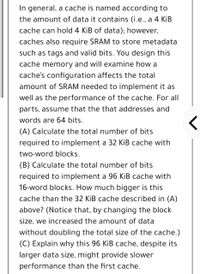
Computer Networking: A Top-Down Approach (7th Edition)
7th Edition
ISBN: 9780133594140
Author: James Kurose, Keith Ross
Publisher: PEARSON
expand_more
expand_more
format_list_bulleted
Question

Transcribed Image Text:In general, a cache is named according to
the amount of data it contains (i.e., a 4 KİB
cache can hold 4 KiB of data); however,
caches also require SRAM to store metadata
such as tags and valid bits. You design this
cache memory and will examine how a
cache's configuration affects the total
amount of SRAM needed to implement it as
well as the performance of the cache. For all
parts, assume that the that addresses and
words are 64 bits.
(A) Calculate the total number of bits
required to implement a 32 KİB cache with
two-word blocks.
(B) Calculate the total number of bits
required to implement a 96 KiB cache with
16-word blocks. How much bigger is thi
cache than the 32 KiB cache described in (A)
above? (Notice that, by changing the block
size, we increased the amount of data
without doubling the total size of the cache.)
(C) Explain why this 96 KiB cache, despite its
larger data size, might provide slower
performance than the first cache.
Expert Solution
This question has been solved!
Explore an expertly crafted, step-by-step solution for a thorough understanding of key concepts.
This is a popular solution
Trending nowThis is a popular solution!
Step by stepSolved in 3 steps

Knowledge Booster
Similar questions
- consider someone is using direct-mapped cache memory, each external memory address maps to what? a specific cache memory location one of many different cache memory locations a unique cache memory location, not shared with other external addresses a randomly-selected cache memory locationarrow_forwardWhat are the obstacles to developing a cache replacement mechanism that is compatible with any given address sequence?arrow_forwardDirect Mapping Example: CPU is searching an Instruction stored at RAM address 1110011010 in cache and doesn't find it. What happens then? Tag 0000000000 ?? 0000000001 ?? Block:0, (j=0) 0000000010 Instruction-1 Line1 = 1 Tag Tag 0000000011 Instruction-2 0000000100 Instruction-3 Instruction-4 Block:1, G=1) Solution: 0000000101 Line 2 (= 2) Tag 0000000110 Instruction-5 0000000111 Instruction-6 0000001100 Instruction-7 0000001101 Instruction-8 Block:2 0000001110 Data-1 (j=2) 0000001111 Data-2 Line.3 (3) 0000011100 Data-3 0000011101 Data-4 Tag 0000011110 Data-5 0000011111 Data-6 Cache Size = 64B Size of a line = 4B Total number of Lines in Cache: m 16 RAM Size = 1KB %3D 1111111100 %3D Size of a Block= 4B Total number of Blocks, M = 256 j = 0, 1, 2, ..255 (M-1) Block 255. G =255) 1111111101 1111111110 i = 0, 1, 2, ... 15 (m-1) 1111111111arrow_forward
- The phrases "unified cache" and "Hadley cache" should be defined.arrow_forwardIn a certain computer, the virtual addresses are 32 bits long and the physical addresses are 48 bits long. The memory is word addressable. The page size is 16 kB and the word size is 2 bytes. The Translation Look-aside Buffer (TLB) in the address translation path has 64 valid entries. Hit ratio of TLB is 100% then maximum number of distinct virtual addresses that can be translated is K.arrow_forwardConsider a 32-bit computer using byte-addressable memory accessing different types of cache. Each cache consists of 256 blocks with one 32-bit word per block. Specify how many bits are used for the tag, index or set, and byte offset for each type of cache listed in the table below.arrow_forward
- Question 4arrow_forwardFor a direct-mapped cache design with a 32-bit address, the following bits of the address are used to access the cache. Tag 31-10 Index 9-5 a. What is the cache block size (in words)? b. How many entries does the cache have? Offset 4-0 c. What is the ratio between total bits required for such a cache implementation over the data storage bits?arrow_forwardIf a processor sends a cache-unfulfilled request while a block is being written back to main memory, should something happen?arrow_forward
arrow_back_ios
arrow_forward_ios
Recommended textbooks for you
 Computer Networking: A Top-Down Approach (7th Edi...Computer EngineeringISBN:9780133594140Author:James Kurose, Keith RossPublisher:PEARSON
Computer Networking: A Top-Down Approach (7th Edi...Computer EngineeringISBN:9780133594140Author:James Kurose, Keith RossPublisher:PEARSON Computer Organization and Design MIPS Edition, Fi...Computer EngineeringISBN:9780124077263Author:David A. Patterson, John L. HennessyPublisher:Elsevier Science
Computer Organization and Design MIPS Edition, Fi...Computer EngineeringISBN:9780124077263Author:David A. Patterson, John L. HennessyPublisher:Elsevier Science Network+ Guide to Networks (MindTap Course List)Computer EngineeringISBN:9781337569330Author:Jill West, Tamara Dean, Jean AndrewsPublisher:Cengage Learning
Network+ Guide to Networks (MindTap Course List)Computer EngineeringISBN:9781337569330Author:Jill West, Tamara Dean, Jean AndrewsPublisher:Cengage Learning Concepts of Database ManagementComputer EngineeringISBN:9781337093422Author:Joy L. Starks, Philip J. Pratt, Mary Z. LastPublisher:Cengage Learning
Concepts of Database ManagementComputer EngineeringISBN:9781337093422Author:Joy L. Starks, Philip J. Pratt, Mary Z. LastPublisher:Cengage Learning Prelude to ProgrammingComputer EngineeringISBN:9780133750423Author:VENIT, StewartPublisher:Pearson Education
Prelude to ProgrammingComputer EngineeringISBN:9780133750423Author:VENIT, StewartPublisher:Pearson Education Sc Business Data Communications and Networking, T...Computer EngineeringISBN:9781119368830Author:FITZGERALDPublisher:WILEY
Sc Business Data Communications and Networking, T...Computer EngineeringISBN:9781119368830Author:FITZGERALDPublisher:WILEY

Computer Networking: A Top-Down Approach (7th Edi...
Computer Engineering
ISBN:9780133594140
Author:James Kurose, Keith Ross
Publisher:PEARSON

Computer Organization and Design MIPS Edition, Fi...
Computer Engineering
ISBN:9780124077263
Author:David A. Patterson, John L. Hennessy
Publisher:Elsevier Science

Network+ Guide to Networks (MindTap Course List)
Computer Engineering
ISBN:9781337569330
Author:Jill West, Tamara Dean, Jean Andrews
Publisher:Cengage Learning

Concepts of Database Management
Computer Engineering
ISBN:9781337093422
Author:Joy L. Starks, Philip J. Pratt, Mary Z. Last
Publisher:Cengage Learning

Prelude to Programming
Computer Engineering
ISBN:9780133750423
Author:VENIT, Stewart
Publisher:Pearson Education

Sc Business Data Communications and Networking, T...
Computer Engineering
ISBN:9781119368830
Author:FITZGERALD
Publisher:WILEY